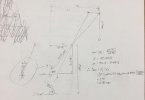I'm not sure this is the place for this subject: not all right/left POI shift is scope related.
I actually built a very precise adj fixture for Setting plumb on a scope. I can dial neg or *** roll to seconds.
Barrel indexing must always be considered. You can have a scope dialed in exactly 00.00.00 and still have right/left POI shift at distances. This is particularly true of Rems and other off the shelf OEM guns. Also true for many so called "Custom" guns built by ppl who think action/chamber alignment only. Every barrel bore has a bow in it. No bore is perfectly straight. Even with the barrel chambered and mated to the action perfectly, if the muzzle/bore variation is not indexed perfectly in the vertical alignment then a 100 yard windage zero can be off by MOAs at 1000 yards with a perfectly set up scope. In other words the scope is tracking 6 to 12 O'clock but the muzzle is pointed 7 to 2 O'clock. Your POI will be farther to the right the farther you shoot.
I use my jig to align the scope to where the gun prints. If I'm level but the gun shoots 1 moa right at 1000 I use my jig to move the scope to match the barrel.
Thought Id add:
Initially I set my rifle/scopes up with a level and a plumb bob. I zero the rifle for elevation and windage at 100 yards.
I then dial in my ups and shoot 1000. From that point I never look to the level again.
I set up Precision machine tools for years. Its hard enough to dial in a couple thousandths with a 12" Precision level. I do not believe anyone can use a 2" level on a rifle scope and get an adjustment of 2 moa. That would be 3/10ths of one thousandth of rotation or .0003".
My jig has a 3.000" arm. (3" Radius) from center axis of scope tube to the contact point for a .0001 indicator. The diameter of the theoretical circle is 6.000". 6" x 3.1416" = 18.85" circumference/360 degrees = .0523" rotation per 1-degree. / 60 minutes of angle per degree = .000872" of rotation per MOA.
At some point tangent/secant (whatever) has to be converted into a linear distance that can be measured.
Once set up and the indicator zeroed,
The rings are loosened slightly.
The jig uses a captured jacking screw clamped to the scope that jacks against an arm mounted to the base to rotate the scope.
My jig holds the scope tube in relationship to the base and then uses an independent jacking arm with an indicator. I simply dial in the "fix" and lock the rings. I release the jacking clamp. If my indicator still shows the same value I'm done.
Once a rifle is set up like this the scope/rings are set to that gun's barrel only and cannot be switched to other guns without re setting to the new gun.
There will be no photos. Sorry. Took me a long time to design and build this thing.
Once done, a rifle with a quality scope will track +/- 0 MOA right/left windage to infinity and back to 100.

